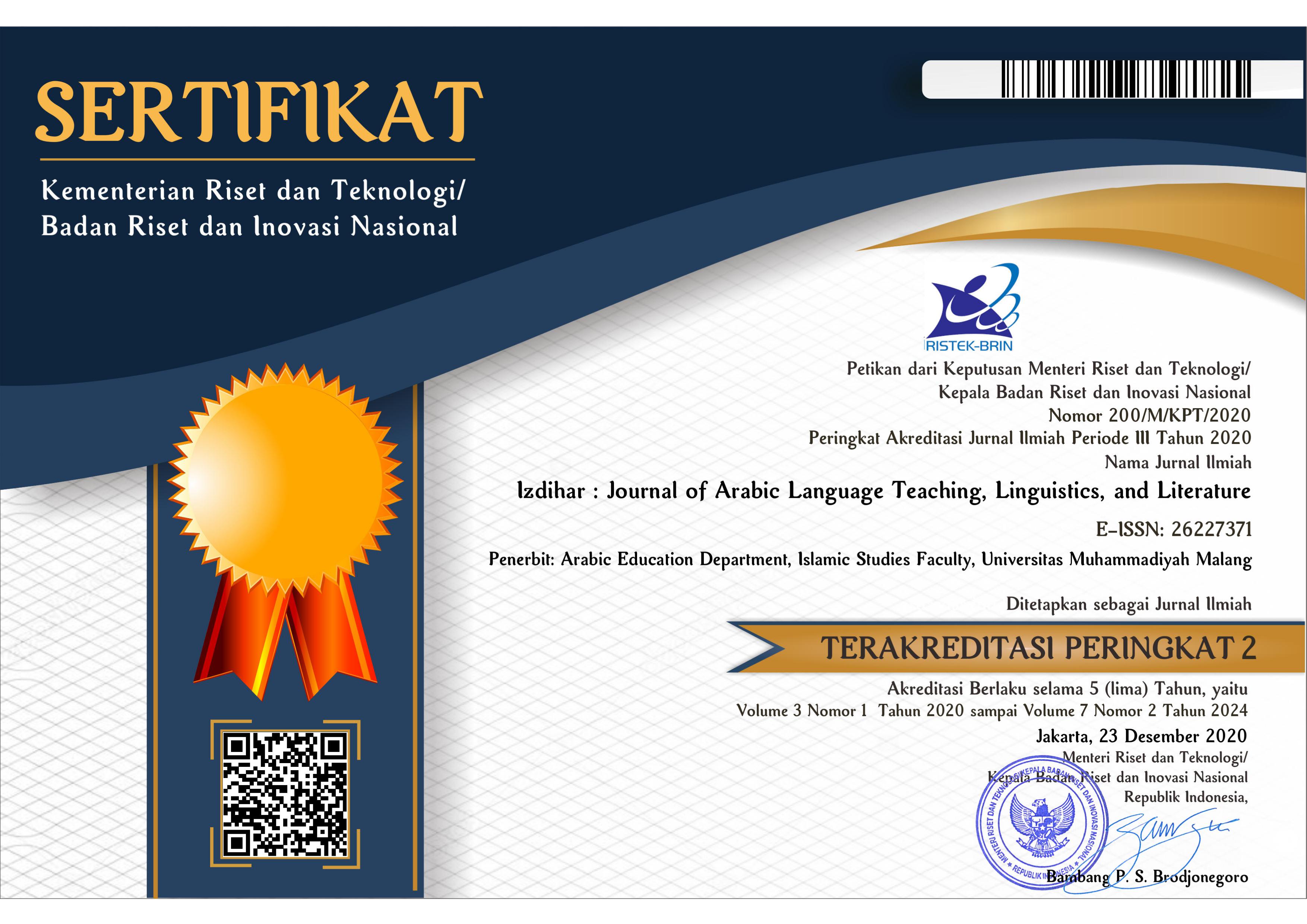Meaning Variations of Qāla (قال) in Indonesian Language
DOI:
https://doi.org/10.22219/jiz.v2i2.9909Keywords:
Meaning Variation, Qāla (قال), TranslationAbstract
One of main component for every language is verb. In Arabic, qāla (قال) is one of verbs which substantively is used in many oral and written language due to its wide meaning. This research focuses on meaning variation of qāla (قال) when it was translated into Indonesian. In this study, differential meaning can be caused by differential speaker and also differential context. Thereby, the research aims to classify and explain every single meaning of qāla (قال) verb. This descriptive qualitative research uses observation method with tapping technique. Meanwhile, the data was analyzed by translational method, referential method, and pragmatics method. The result of the research shows that; (1) There are three differential meanings of qāla (قال) according to speaker perspective, as well as ‘berfirman’, ‘bersabda’, and ‘berkata’. (2) There are some differential meanings of qāla (قال) according to linguistics perspective, such as ‘berkata, mengatakan, mengabarkan, mengumumkan, berbicara, mengucapkan, mengaku, pendapat, bertanya, menjawab, perintah, and berdoa.
Downloads
References
Baihaki, E. S. (2017). Penerjemahan Al-Qur’an: Proses Penerjemahan al-Qur’an di Indonesia. Jurnal Ushuluddin, 25(1), 44-55. doi: http://dx.doi.org/10.24014/jush.v25i1.2339
Baker, M. (2011). In Other Words: A Course Book on Translation. London: Routledge.
Farikhatunnisak, L. (2015). Penerjemahan Verba Qāla ke dalam Bahasa Inggris: Studi Kasus pada The Meaning of the Glorious Quran Karya Muhammad Marmaduke Pickthall. Universitas Gadjah Mada, Yogyakarta.
Fauzi, M. F., & Anindiati, I. (2019). تطوير اللغز الرقمي لمادة التطبيق الصرفي 1 على الهاتف المحمول كالتدريبات الإضافية خارج الفصل الدراسي. Buletin Al-Turas, 25(1), 129-139. DOI: https://doi.org/10.15408/bat.v25i1.11506
Fengling, L. (2017). A Comparative Study of Nida and Newmark’s Translation Theories. International Journal of Liberal Arts and Social Science, 5(8), 31-39.
Furqon, M. R., & Fauzi, M. F. (2019). The Values of Educational Character in the Arabic Temples of Qasidah Burdah by Imam Bushiri. Izdihar: Journal of Arabic Language Teaching, Linguistics, and Literature, 2(1), 67–76. DOI: https://doi.org/10.22219/jiz.v2i1.8327
Hamza, S. (2015). Terjemahan Alquran dari Masa ke Masa. Jurnal Suhuf, 27(1), 74-89.
Irhamni. (2011). Strategi Penerjemahan: Kreatif Menerjemahkan Bahasa Arab – Indonesia. Malang: Pustaka Kaiswaran.
Jackson, M. (2000). Seeing Language: Using Non-fiction to Teach Students About Language. Language Arts Journal of Michigan, 16(1), 12. doi: https://doi.org/10.9707/2168-149X.1369
Lubis, I. (2004). Ihwal Penerjemahan Bahasa Arab ke Dalam Bahasa Indonesia. Jurnal Humaniora, 16(1), 96-104. doi: https://doi.org/10.22146/jh.810
Masqon, D. (2018). دور اللغة العربية في عصر العولمة وتطبيقها في تطوير العلوم. Izdihar: Journal of Arabic Language Teaching, Linguistics, and Literature, 1(1), 25–64. DOI: https://doi.org/10.22219/izdihar.v1i1.6562
Mubarok, H. (2008). Analisis Komponen Makna Kata Al Kalam dan Al Qaul dalam Al-Quran Al Karim. Universitas Indonesia, Depok.
Mulyadi. (2019). Kategori dan Peran Semantis Verba dalam Bahasa Indonesia. Logat: Jurnal Ilmiah Bahasa dan Sastra, 5(1), 56-65.
Nida, E. A. (2006). Theories of translation. Pliegos de Yuste: revista de cultura y pensamiento europeos, 1(4), 11-14.
Owji, Z. (2013). MA, 2013. Translation strategies: A review and comparison of theories. Translation Journal, 17(1).
Panou, D. (2013). Equivalence in translation theories: A critical evaluation. Theory and Practice in Language Studies, 3(1), 1. doi: doi:10.4304/tpls.3.1.1-6
Parker, F., & Riley, K. (2014). Linguistics for Non-Linguists. Singapore: Pearson Education South Asia Pte Ltd.
Perdana, D. H. (2017). Strategi Penerjemahan Bahasa Arab Yang Berterima dan Mudah Dipahami. IAIN Tulungagung Research Collections, 9(1), 143-160. doi: 10.21274/ls.2017.9.1.143-160
Putranti, A. (2015). Synonymy: A Translation Procedure to Overcome Problems of SL and TL Cultural Differences. Journal of Language and Literature, 15(2), 168-172.
Râbacov, G. (2013). Self-translation as Mediation between Cultures. International Journal of Communication Research, 3(1), 66.
Siddiek, A. G. (2012). Viewpoints in the Translation of the Holy Quran. International Journal of Applied Linguistics and English Literature, 1(2), 18-25.
Silalahi, R. (2016). Variation Results in Translating English Verbs into Indonesia. International Journal of Linguistics and Communication, 4(1), 39-48.
Stine, P. (2012). Eugene A. Nida: Theoretician of Translation. International Bulletin of Missionary Research, 36(1), 38-39.
Ullmen, S. (2011). Pengantar Semantik. Yogyakarta: Pustaka Pelajar.
Wang, T., & Hirst, G. (2012). Exploring Patterns in Dictionary Definitions for Synonym Extraction. Natural Language Engineering, 18(3), 313-342. doi: https://doi.org/10.1017/S1351324911000210
Wijana, I. D. P. (2011). Berkenalan dengan Linguistik. Yogyakarta: A.com Press.
Yinhua, X. (2011). Equivalence in Translation: Features and Necessity. International Journal of Humanities and Social Science, 1(10), 169-171.
Primary Data Sources
Al Bugha, M. D. (2009). Al Wafi: Syarah Kitab Arba’in An Nawawiyah. Jakarta: Al I’tishom.
Al Fauzan, A. I., Husain, M. T., & Fadhil, M. A. K. M. (2002). Al ‘Arabiyyah Baina Yadaik 2. Riyadh: Al Maktab Ar Ra’isy Al ‘Arabiyyah lil Jami’ Al Waqful Islamiy.
Q.S. Ali ‘Imran ([3]: 24)
Q.S. Ali Imran ([3]: 35).
Q.S. Ali ‘Imran ([3]: 47).
Q.S. Al An’ām ([6]: 23)
Q.S. Al Baqarah ([2]: 13)
Q.S. Al Baqarah ([2]: 59)
Q.S. Al Baqarah ([2]: 156)
Q.S. Al Baqarah ([2]: 259)
Q.S. Al Hijr ([15]: 52)
Q.S. Al Isrā’ ([17]: 40)
Q.S. Al Māidah ([5]: 116)
Q.S. Al Mu’minūn ([23]: 81)
Q.S. Al Qashash ([28]: 21)
Q.S. Al Zalzalah ([99]: 3)
Q.S. An Naml ([27]: 15)
Q.S. Thāhā ([20]: 44)
Q.S. Yusuf ([12]: 4)
Q.S. Yusuf ([12]: 5)
https://doi.org/10.15408/bat.v25i1.11506
Downloads
Published
How to Cite
Issue
Section
License
Copyright Notice
Authors who publish with this journal agree to the following terms:
- Authors retain copyright and grant the journal right of first publication with the work simultaneously licensed under a Creative Commons Attribution-ShareAlike 4.0 International License that allows others to share the work with an acknowledgment of the work's authorship and initial publication in this journal.
- Authors are able to enter into separate, additional contractual arrangements for the non-exclusive distribution of the journal's published version of the work (e.g., post it to an institutional repository or publish it in a book), with an acknowledgment of its initial publication in this journal.
- Authors are permitted and encouraged to post their work online (e.g., in institutional repositories or on their website) prior to and during the submission process, as it can lead to productive exchanges, as well as earlier and greater citation of published work (See The Effect of Open Access).
Copyright (c) 2019 Izdihar : Journal of Arabic Language Teaching, Linguistics, and Literature

This work is licensed under a Creative Commons Attribution-ShareAlike 4.0 International License.

















